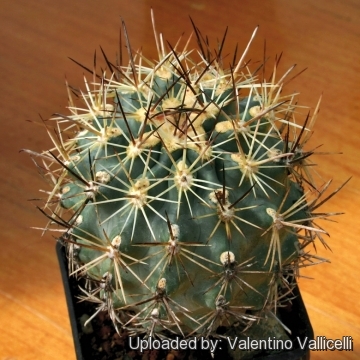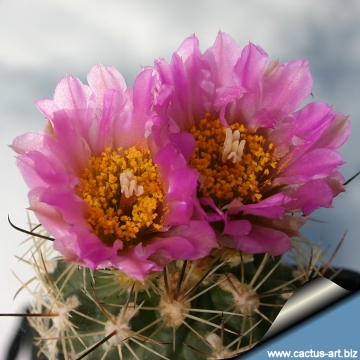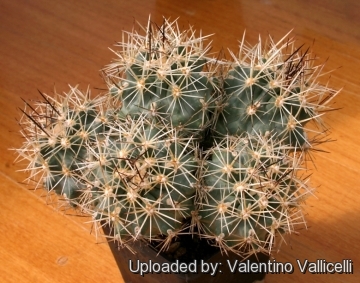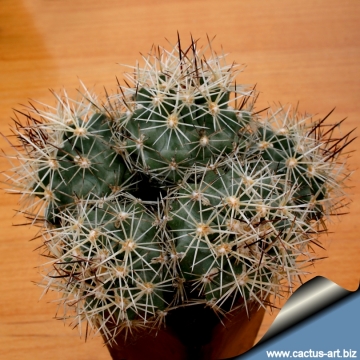Accepted Scientific Name: Sclerocactus wetlandicus Hochstätter
Succulenta (Netherlands) 68: 123, figs. 1989

Sclerocactus glaucus subs. wetlandicus (Sclerocactus wetlandicus) Photo by: Valentino Vallicelli
SB 1323 Uintah County, Utah, USA
Origin and Habitat: Duchesne and Uintah counties, Utah. (Southwestern U.S.A., Northern America)
Altitude: 1250-1950 metres above sea level.
Habitat: Gravel-covered clay hills, desert grasslands, saltbush, rabbit brush flats; of conservation concern.
Synonyms:
See all synonyms of Sclerocactus wetlandicus
Common Names include:
ENGLISH: Uinta Basin Hookless Cactus
Description: Sclerocactus wetlandicusSN|13869]]SN|13869]] is a rare north American cactus with central spines not greatly different from radial spines. Some plants lack central spines, or have central spines which are hooked. It is quite variable.
Habit: Usually solitary or occasionally clumping, in groups of up to 9 stems.
Stem: Green to bluish green (glaucous) squat, spheric, cylindric, or elongate-cylindric, 3-8,5(-15)tall and 4-10(-12) cm on diameter.
Ribs: 12-14(-15) tubercles evident on ribs.
Areoles: 3 mm in diameter, 9-10 mm apart. Red nectar glands are found above each areole.
Spines: Slightly or not obscuring stems.
Radial spines: 6-10(or more) per areole, white, creas, pale tan, brown, reddish brown (rarely black), 6-20 mm, central spines 3-5 per areole, sometimes not greatly different from radial spines; straight and unhooked or curved (rarely hooked), 12-26 mm long.
Central spines: 3-4(-5) per areole, sometimes not greatly different from radial spines, usually white (rarely light brown), 15-29 mm long. Some specimens lack central spines, or have central spines which are hooked.
Flowers: Purple or pink flowers fragrant, funnel-form, 2,5-5 cm wide and tall; outer tepals with brownish lavender midstripes and pink to violet margins, filaments green to white; anthers yellow.
Fruits: Ovoid, barrel-shaped, 9-30 long, 7-12 mm across, with a few membranous scales, mostly near apex.
Seeds: Black, 1,5 long, 2,5 mm broad; cells convex but flattened apically.
Blooming season: Spring (In habitat from late April to May).
Subspecies, varieties, forms and cultivars of plants belonging to the Sclerocactus glaucus group
 Sclerocactus franklinii J. W. Evans: is s local form of Sclerocactus glaucus, but not sufficiently distinct to deserve its own formal status. Distribution: Mesa and Delta County, Colorado.
Sclerocactus franklinii J. W. Evans: is s local form of Sclerocactus glaucus, but not sufficiently distinct to deserve its own formal status. Distribution: Mesa and Delta County, Colorado.- Sclerocactus glaucus (K.Schum.) L.D.Benson: Ball-shaped cactus, single or clumping. Stems green or powdery blue coloured 4 to 30 cm tall, 4 to 9 cm in diameter. Central spines unhooked, the lower ones brown, the upper ones white 1-3 cm long, 6 to 8 radials, 5 mm long. Flowersl purplish-red or pink.
 Sclerocactus glaucus '' Debeque form '' (K.Schum.) L.D.Benson: It has tall larger blue body with stiff spines. It grows in northern edge of distribution for this species.
Sclerocactus glaucus '' Debeque form '' (K.Schum.) L.D.Benson: It has tall larger blue body with stiff spines. It grows in northern edge of distribution for this species. Sclerocactus glaucus f. cristata hort.: Crested form easily recognizable for the characteristic unhooked central spines.
Sclerocactus glaucus f. cristata hort.: Crested form easily recognizable for the characteristic unhooked central spines.- Sclerocactus glaucus subs. wetlandicus var. ilseae (Hochstätter) Hochstätter
 Sclerocactus wetlandicus Hochstätter: Morphologically very similar to Sclerocactus glaucus, but the two populations are geographically separated.
Sclerocactus wetlandicus Hochstätter: Morphologically very similar to Sclerocactus glaucus, but the two populations are geographically separated. Sclerocactus wetlandicus f. cristata hort.: Crested form easily with unhooked central spines. Several clones do exist.
Sclerocactus wetlandicus f. cristata hort.: Crested form easily with unhooked central spines. Several clones do exist.
Bibliography: Major references and further lectures
1) James Cullen, Sabina G. Knees, H. Suzanne Cubey “The European Garden Flora Flowering Plants: A Manual for the Identification of Plants Cultivated in Europe, Both Out-of-Doors and Under Glass” Cambridge University Press, 11/Aug./2011
2) David Hunt, Nigel Taylor “The New Cactus Lexicon” DH Books, 2006
3) Edward F. Anderson “The Cactus Family” Timber Press, 2001
4) Sclerocactus wetlandicus in: “Flora of North America North of Mexico, vol. 4: Magnoliophyta: Caryophyllidae, part. 1” Oxford University Press New York, New York, USA
5) Sclerocactus wetlandicus in: http://www.efloras.org/florataxon.aspx?flora_id=1&taxon_id=242415287 downloades on 20/08/2013
 Sclerocactus glaucus subs. wetlandicus (Sclerocactus wetlandicus) Photo by: Valentino Vallicelli
Sclerocactus glaucus subs. wetlandicus (Sclerocactus wetlandicus) Photo by: Valentino Vallicelli Sclerocactus glaucus subs. wetlandicus (Sclerocactus wetlandicus) Photo by: Cactus Art
Sclerocactus glaucus subs. wetlandicus (Sclerocactus wetlandicus) Photo by: Cactus Art Sclerocactus glaucus subs. wetlandicus (Sclerocactus wetlandicus) Photo by: Cactus Art
Sclerocactus glaucus subs. wetlandicus (Sclerocactus wetlandicus) Photo by: Cactus Art Sclerocactus glaucus subs. wetlandicus (Sclerocactus wetlandicus) Photo by: Valentino Vallicelli
Sclerocactus glaucus subs. wetlandicus (Sclerocactus wetlandicus) Photo by: Valentino Vallicelli Sclerocactus glaucus subs. wetlandicus (Sclerocactus wetlandicus) Photo by: Cactus Art
Sclerocactus glaucus subs. wetlandicus (Sclerocactus wetlandicus) Photo by: Cactus ArtSend a photo of this plant.The gallery now contains thousands of pictures, however it is possible to do even more. We are, of course, seeking photos of species not yet shown in the gallery but not only that, we are also looking for better pictures than those already present.
Read More... Cultivation and Propagation: This plant is very rare in cultivation; it does not do well. It is very difficult to grow its own roots. Mature individuals easily rot and die, especially after planting.
It is extremely xerophytic and adapted to very dry soils, but plant grafted an hardy Opuntia compressa stock are very easy to grow and no special skill is required, they can stay in a non heated green house or outdoors in raised beds, terraces, window sills etc..
This cactus continues to be, a particular prize among collectors.
Propagation: Seeds are extremely difficult to germinate (only 2-3 percent of seeds germinate) The germination is really difficult and if some seedling finally sprout, as they start to grows they disappear one by one. Grafting is often used to speed growth rate and to create a back-up for plants in collection.
















